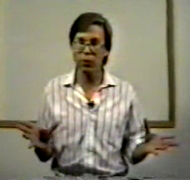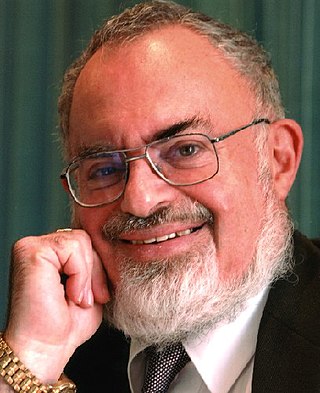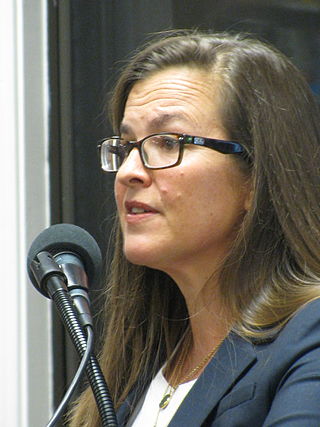William Poundstone is an American author, columnist, and skeptic. He has written a number of books including the Big Secrets series and a biography of Carl Sagan.
William Poundstone is an American author, columnist, and skeptic. He has written a number of books including the Big Secrets series and a biography of Carl Sagan.
Poundstone attended MIT and studied physics. [1]
An enthusiastic fan of the fiction author Harry Stephen Keeler, Poundstone maintains the Keeler homepage and contributed to the anthology A to Izzard: A Harry Stephen Keeler Companion (2002).
He is a cousin of comedian Paula Poundstone. [2]

Carl Edward Sagan was an American astronomer, planetary scientist, and science communicator. His best known scientific contribution is his research on the possibility of extraterrestrial life, including experimental demonstration of the production of amino acids from basic chemicals by exposure to light. He assembled the first physical messages sent into space, the Pioneer plaque and the Voyager Golden Record, which were universal messages that could potentially be understood by any extraterrestrial intelligence that might find them. He argued in favor of the hypothesis, which has since been accepted, that the high surface temperatures of Venus are the result of the greenhouse effect.

James Randi was a Canadian-American stage magician, author, and scientific skeptic who extensively challenged paranormal and pseudoscientific claims. He was the co-founder of the Committee for Skeptical Inquiry (CSI), and founder of the James Randi Educational Foundation (JREF). Randi began his career as a magician under the stage name The Amazing Randi and later chose to devote most of his time to investigating paranormal, occult, and supernatural claims. Randi retired from practicing magic at age 60, and from his foundation at 87.

Martin Gardner was an American popular mathematics and popular science writer with interests also encompassing magic, scientific skepticism, micromagic, philosophy, religion, and literature – especially the writings of Lewis Carroll, L. Frank Baum, and G. K. Chesterton. He was a leading authority on Lewis Carroll; The Annotated Alice, which incorporated the text of Carroll's two Alice books, was his most successful work and sold over a million copies. He had a lifelong interest in magic and illusion and in 1999, MAGIC magazine named him as one of the "100 Most Influential Magicians of the Twentieth Century". He was considered the doyen of American puzzlers. He was a prolific and versatile author, publishing more than 100 books.

Derren Brown is an English mentalist, illusionist, and writer. He is a self-described "psychological illusionist" whose acts are often designed to expose the methods of those who claim to possess supernatural powers, such as faith healers and mediums. His live performances, which heavily incorporate audience participation and comedy, usually begin with him reminding the audience that his results are achieved through a combination of psychology, showmanship, magic, misdirection, and suggestion.

The Roswell incident is a conspiracy theory which alleges that the 1947 crash of a United States Army Air Forces balloon near Roswell, New Mexico was actually caused by an extraterrestrial spacecraft. The theory was popularized in the 1980 book of the same name.

Robert Scott Lazar is an American conspiracy theorist. In 1989, Lazar claimed to have been part of a classified US government project concerned with the reverse engineering of extraterrestrial technology; he also purported to have read government briefing documents that described alien involvement in human affairs over the past 10,000 years. A self-proclaimed physicist, Lazar supposedly worked at a secret site near the United States Air Force facility popularly known as Area 51. His story brought additional public attention to the facility and spawned conspiracy theories regarding government knowledge of extraterrestrial life.
A debunker is a person or organization that exposes or discredits claims believed to be false, exaggerated, or pretentious. The term is often associated with skeptical investigation of controversial topics such as UFOs, claimed paranormal phenomena, cryptids, conspiracy theories, alternative medicine, religion, or exploratory or fringe areas of scientific or pseudoscientific research.

Karl Sven Woytek Sas Konkovitch Matthew Kruszelnicki, often referred to as "Dr Karl", is an Australian science communicator and populariser, who is known as an author and a science commentator on Australian radio, television, and podcasts.

Stanton Terry Friedman was an American–Canadian nuclear physicist and professional ufologist who was based in Fredericton, New Brunswick, Canada.
William Roland Hartston is an English journalist who wrote the Beachcomber column in the Daily Express. He is also a chess player who played competitively from 1962 to 1987 and earned a highest Elo rating of 2485. He was awarded the title International Master in 1972, but is now best known as a chess author and presenter of the game on television.

The New Inquisition is a book written by Robert Anton Wilson and first published in 1986. The New Inquisition is a book about ontology, science, paranormal events, and epistemology. Wilson identifies what he calls "Fundamentalist Materialism" belief and compares it to religious fundamentalism.
Judy "Zebra"Knight is an American spiritual teacher and author known for her purported channelling of a spiritual entity named Ramtha. Critics consider her to be a cult leader.
A coding interview, technical interview, programming interview or Microsoft interview is a technical problem-based job interview technique to assess applicants for a computer programming or software development position. Modern coding interview techniques were pioneered by Microsoft during the 1990s and adopted by other large technology companies including Amazon, Facebook, and Google. Coding interviews test candidates' technical knowledge, coding ability, problem solving skills, and creativity, typically on a whiteboard. Candidates usually have a degree in computer science, information science, computer engineering or electrical engineering, and are asked to solve programming problems, algorithms, or puzzles. Coding interviews are typically conducted in-person or virtually.
Ed Zotti is a journalist and urban transit planner in Chicago, Illinois. He is credited as being the "editor and confidant" of Cecil Adams, the pseudonym of the writer of the column "The Straight Dope".
Big Secrets is a series of books written by William Poundstone, and also the title of the first book in the series.

Annie Jacobsen is an American investigative journalist, author, and a 2016 Pulitzer Prize finalist. She writes for and produces television programs, including Tom Clancy's Jack Ryan for Amazon Studios, and Clarice for CBS. She was a contributing editor to the Los Angeles Times Magazine from 2009 until 2012.
Marcus Chown is a science writer, journalist and broadcaster, currently cosmology consultant for New Scientist magazine.
Daniel Loxton is a Canadian writer, illustrator, and skeptic. He wrote or co-wrote several books including Tales of Prehistoric Life, a children's science trilogy, and Abominable Science!, a scientific look at cryptozoology. As editor of Junior Skeptic, Loxton writes and illustrates most issues of Junior Skeptic, a children's science section in the Skeptics Society's Skeptic magazine.
List of works by or about Timothy Ferris, American science writer.
Bibliography of works on The Simpsons is a list of works about the American multimedia franchise The Simpsons, its themes, and its cultural influence.